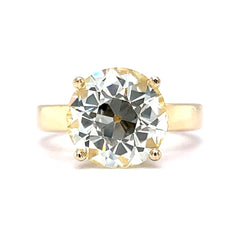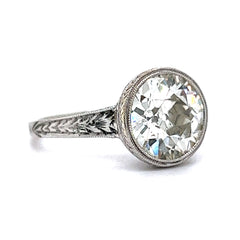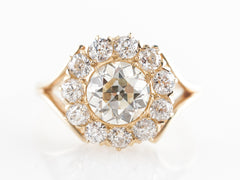Table of Contents
- Introduction to Old European Cut Diamonds
- The Birth and Artistry of Antique Diamonds
- Key Features of Old European Cut Diamonds
- The Golden Age: Art Deco and Beyond
- Comparing Old Euros and Modern Rounds
- Choosing Your Diamond: Personal Taste Matters
- Engage with History: Embracing Antique Diamonds
- Next Steps: Discover Your Perfect Diamond
View our entire collection of vintage engagement rings here:
Introduction to Old European Cut Diamonds
Old European cut diamonds are a window to the past. These unique stones are are very similar to modern round brilliant cut diamonds but have subtle differences that enhance their individuality.
In this article we'll discuss the many facets (pun intended!) of these diamond cuts and why they have become so sought after by collectors as well as those looking for something different.
The Birth and Artistry of Antique Diamonds
Diamond cutters in the late 1800s and early 1900s began cutting stones in this fashion to enhance the play of light in lower light conditions as electric overhead lighting hadn't taken hold quite yet. Old European cut diamonds are often referred to as "fireside diamonds". The larger facets allowed the stones to have a glittery effect (think disco ball). These artisans crafted each facet by hand, enhancing the diamond's natural sparkle without the aid of modern technology.
These diamonds have a high crown, small table, and noticeable culet. This gives them a rare depth and inner sparkle not found in modern cuts.

5 Carat old European Cut Diamond
Key Features of Old European Cut Diamonds
Old European cut diamonds have distinct characteristics when compared to modern round brilliant cuts:
- High Crown and Small Table: This combination provides a distinct profile and mesmerizing light play.
- Prominent Culet: The larger culet creates a visible, dark circle at the center, adding to its vintage charm.
- Large Facets: These enhance the diamond's unique sparkle, making it a favorite among those who appreciate antique beauty.

The Golden Age: Art Deco and Beyond
During the Art Deco, Edwardian, and Victorian eras, Old European cut diamonds flourished. These diamonds are usually the main focus of engagement rings with detailed designs and smaller accent stones surrounding them. This era marked a renaissance of diamond craftsmanship, which gradually led to the development of modern diamond cuts.
Comparing Old Euros and Modern Rounds
Modern round brilliants optimize for maximum white light reflection, while Old European cuts prioritize a distinctive "inner fire." Many people adore the mesmerizing effect of the visible culet and reflections in vintage design. However, it may not be as brilliant as modern styles. Old European cut diamonds have a "glitter" effect while modern diamonds sparkle.

Choosing Your Diamond: Personal Taste Matters
Deciding between an Old European cut or modern diamonds is a personal choice. It depends on whether you prefer historical richness or precise brilliance. Your preference will guide you in making the right decision for you.
An Old European cut diamond is not just a gem. It is a piece of history that showcases the skill of diamond cutters from the past. It also represents classic beauty.
Engage with History: Embracing Antique Diamonds
If you're drawn to the unique and the historical, consider an Old European cut diamond for your engagement ring. Each piece is a one-of-a-kind treasure, offering not only beauty but a connection to a bygone era. Remember, choosing a diamond is about what resonates with your personal taste and what story you want to wear and cherish.
Next Steps: Discover Your Perfect Diamond
Ready to explore the enchanting world of Old European cut diamonds? Dive into their rich history and unique characteristics to discover why they remain a cherished choice for those seeking both style and substance in their jewelry.

